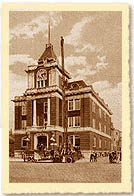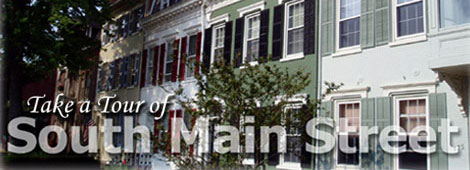|
|
Historic
Photo's of Downtown Geneva, NY
 |
 |
 |
 |
 |
 |
 |
 |
 |
 |
 |
 |
 |
 |
 |
 |
|
Originally known by its Seneca
Indian name of "Kanadesaga,"
Geneva was resettled by
Europeans after the Indians
were dispersed during the
American Revolution. Charles
Williamson, agent for the
Pulteney Group of English
investors, is known as the
"Founder of Geneva." Streets
were laid out in 1793, and
building rapidly increased
after 1796. Seventeen hundred
and ninety six was a big year
in early Geneva history: the
Geneva Academy (forerunner of
Hobart College) was founded,
the Geneva Hotel opened, the
Geneva post office was
established, the Ontario
Gazette, a newspaper which
served all of western New York
began printing, and the sloop
"Alexander," carrying
commercial trade on Seneca
Lake, was launched.
By the date of incorporation
around 1806, Geneva was the
most important settlement in
the area. By comparison,
Syracuse, known until 1809 as
Bogardus Corners, was an
insignificant hamlet, and
Rochester wasn't settled until
1810. The population of Geneva
(300 people in 1800) increased
to almost 3,000 by 1826. This
was largely due to Geneva's
importance as a trading
center.
Geneva's early economy was
largely based on agriculture.
Farm produce was often shipped
in the form of whiskey or
brandy. There were 13
distilleries in Geneva prior
to 1830, due largely to the
lack of water power for the
establishment of flour mills.
The opening of water routes to
New York City in the early
1820's ended the large-scale
distilling industry in Geneva,
as farmers could ship their
fruit and grains directly to
market. The Erie Canal
connecting Albany to Buffalo
opened in 1825. Towns along
the canal route grew more
rapidly than the off-canal
settlements such as Geneva.
For example, in the decade
1820-1830, Geneva's population
increased 100 percent, but the
populations of Utica,
Syracuse, Buffalo, and
Rochester increased by 183,
282, 314, and 512 percent
respectively.
Geneva has a long academic
tradition. In 1825, the Geneva
Academy attained state
accreditation and became
Geneva College. In 1834, a
Medical College was
established, from which
Elizabeth Blackwell, the first
female medical doctor in
America, was graduated in
1849. The Medical College
moved to Syracuse and became
part of Syracuse University in
1872. Geneva College was
renamed Hobart Free College in
1852 and Hobart College in
1860. The State purchased the
Nehemiah Denton farm for the
establishment of an
agricultural experiment
station in 1882. The Station
became part of Cornell
University in 1923.
Postcards and information
provided by:
Dr. Lindsay A. Lafford, Lord
of Ridley
Visit:
http://lord-of-ridley.com/contents.htm
for more postcards and history
of Geneva


|
|
|
|
|
|
Where to Eat -
Where
to Stay -
Where to Shop -
What to Do
- Available Rentals
Property For Sale -
Historic Photos -
Finger Lakes Area
Visitors Guide -
Downtown Maps -
Events Calendar -
Area Links -
Site Map
Website Sponsored By: Coldwell Banker
Finger Lakes
www.FingerLakesProperties.com
Please Email:
mattparrott@hotmail.com with any
changes, thank you.

















